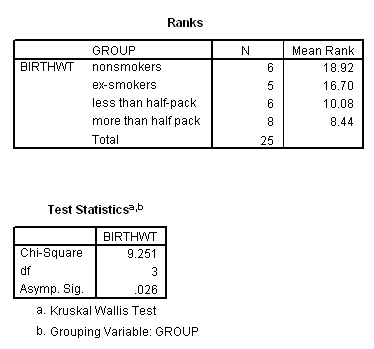
Assigned 2/17; Due 2/24; Returned and discussed 3/3; [Grading sample points]
Comment: The grading key will be posted, but will not be distributed in order to save natural resources. I will mark and annotate students' papers. This was a long HW assignment. The class did exceedingly well as a whole.
(13.2) Multiple comparisons at a = .01
(A) Pr(all three correct) = .993 = .9703;
Pr(at least one wrong) = 1 -
.9703 = .0297 [family-wise error rate acceptable]
(B)
Pr(all 10 correct) = .9910 = .9044;
Pr(at least one wrong) = 1 - .9044 = .0956 [family-wise error rate acceptable]
[1] (C) Pr(all 20 correct) = .9920 = .8179;
Pr(at least one wrong) = 1 - .1821 = .1821 [family-wise error rate too big]
Note: Probabilities are restricted to the range 0 to 1; list between two and four significant figures when reporting probabilities.
(13.6) Fever reduction trial. Mean
reduction in body temp (degrees F)
Group 1 (aspirin): 1.5
Group 2 (aspirin/acetaminophen combination): 0.36
Group 3 (acetaminophen): 0.08
n = 5 (each group)
[2] semean
dif = sqrt(0.4338 * (1/5 + 1/5)) = 0.4166 for each pair-wise comparison
[3,4] Test 1: H0: �1 = �2; tstat = (1.5 -
0.36) / 0.4166 = 2.7364, df = 12; pBonf = .01804 � 3
@ .055
[5,6] Test 2: H0: �1 = �3; tstat = (1.5 -
0.08) / 0.4166 = 3.4085, df = 12; pBonf = .005188 � 3
@ .016
[7,8] Test 3: H0: �2 = �3; tstat = (0.36 - 0.08) / 0.4166 =
0.6721, df = 12;
pBonf = .0.5143 � 3 = an answer that is more than 1, but since
you cannot have a probability that is greater than 1, report it as 1.00 (I'm
surprised there wasn't more chatter on the electronic BBS on this one)
Interpretation: Aspirin is marginally better than the aspirin/acetaminophen combination and is significantly better than acetaminophen alone. [An interpretation was not asked for explicitly; in the future, always interpret your findings.
(13.8) Influence of smoking on birth weight
(A) Rebuttal to a charge of unequal variance
(B) Non-parametric test of H0: population medians are equal
[9] Presentation of K-W output from SPSS

Test results may be reported as c23 = 9.25, p = .026 [modified APA style; df in parentheses seems archaic.]
[10] In using the K-W test, we reject the H0 at a = .05; groups differ significantly.
(C) Post hoc comparisons - I went ahead with a straight LSD post hoc comparisons. This can be justified in terms of prior planned comparisons (I would want to compare all groups ahead of time.) You could also use a Bonferroni method of post hoc comparison, or any other way as long as your method was stated. Before doing the post hoc comparison I would remind myself what I was comparing by listing group means:
n Mean StdDev
nonsmokers 6 7.5833 1.0534
ex-smokers 5 7.2400 0.9127
half-pack 6 6.1833 1.1754
full pack 8 6.0125 0.7200
Total 25 6.6760 1.1352
and recall:
SS df MS
F p
Between 11.508 3 3.836 4.15
.019
Within 19.417 21 0.925
With this background, I computed (with SPSS) the following LSD p values for each comparison:
1 v 2 (p = .56)
1 v 3 (p = .020)*
1 v 4 (p = .0064)*
2 v 3 (p = .084) �
2 v 4 (p = .036)*
3 v 4 (p = .075) �
Comments: